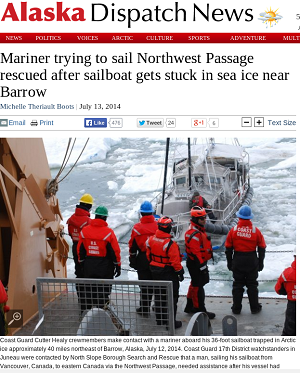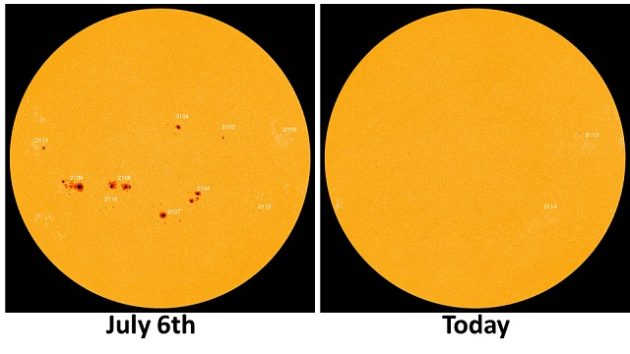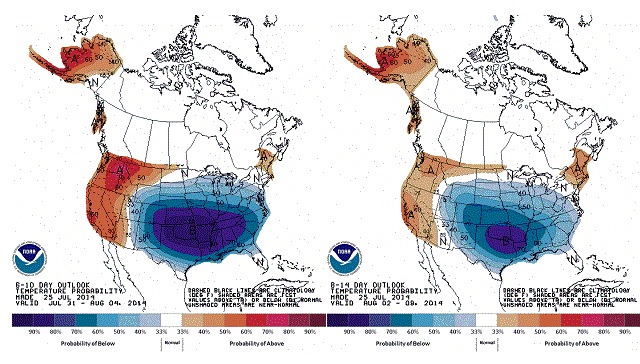Global Cooling: Just a coincidence or a natural solar cycle?
No doubt we all know there are spots on the Sun? Don’t rush out to look; that’s dangerous. If you have a telescope, or even a pair of binoculars, you can focus the Sun’s image onto a piece of paper, held away from the eyepiece. Galileo was the first to see the Sun through his newly-invented telescope, and to report the spots. It caused an uproar in astronomy (and religion), because Aristotle and various revered philosophers had declared the Sun to be a perfect object. Some churchmen refused to believe it, and also refused to come and see for themselves.
Nowadays we have satellites to observe the Sun constantly, since solar flares and outbursts of matter (coronal mass ejections, CMEs) can damage humans in space, communications and observation satellites, and power and communications systems on Earth. The most significant is NASA’s Solar Dynamics Observatory. The people who operate these systems are especially watchful this year, since we’re at the peak of activity in Solar Cycle 24, when sunspots should be most numerous and the Sun’s magnetic field strongest. That’s why the Sun watchers are puzzled. For several days (as of 20 July), there have been no spots.
Our systematic, scientific observation of sunspots goes back to 1755, when we started assigning numbers to sunspot cycles; the current is Cycle 24, and one of the weakest, especially in comparison with #21, #22, and #23. The association between sunspots and terrestrial climate goes much farther back, to the sunspot minimum called the Maunder Minimum, 1645-1720, when virtually no sunspots were observed – and when Earth experienced its coldest temperatures of the Little Ice Age, the coldest period in the last 11,500 years. There was another minimum, the Dalton Minimum, from 1790 – 1820, marked by cold temperatures, that included Napoleon’s invasion of Russia, Charles Dickens’ narratives of cold, snowy London, and America’s Year Without a Summer (1816). The Dalton minimum included SC#5; so far, our SC#24 looks a lot like SC#5. There is a correlation between weak sunspot cycles – which tend to occur several in a row – and cold terrestrial climate. Let’s remember, correlation is not causation, and, until a few years ago, no causation was known.
The mean irradiance from the Sun onto the Earth is well measured, at approximately 1365 watts per sq meter, normalized to Earth’s mean distance from the Sun. It changes very little, 3 or 4 watts/sq meter, much less than 1%. For that reason, most climatologists have dismissed a causal relationship between sunspots or other measures of solar activity with Earth climate.
However, in recent years, Prof Henrik Svensmark of Denmark has proposed another mechanism for climate change resulting from solar changes. The Sun’s magnetic field – which is most of OUR magnetic field – also declines with declining sunspot number. The Sun’s magnetic field shields Earth and the other solar system planets from high-energy cosmic rays, coming from supernovae out in the Milky Way Galaxy. Fortunately, there are no supernovae within a few hundred light-years of Earth. These high-energy cosmic rays (called Galactic Cosmic Rays, or GCRs) ionize molecules in Earth’s atmosphere if they get through the magnetic shield; the ionized molecules then attract water vapor molecules, leading to cloud formation. If the magnetic shield is weak (as it is now), there are more GCRs, more clouds, and colder temperatures. If you’d like to know more, he explains it all in a paperback book, The Chilling Stars, by Svensmark and Calder.
The Svensmark hypothesis has been demonstrated, both in the laboratory at CERN and in nature. The Solar magnetic field occasionally gives a little hiccup, called a Forbush Event, when the field strength drops significantly and more GCRs stream into the atmosphere. Three to four days later, microwave sensors detect increased cloud water content over the oceans (they’re not sensitive to cloud changes over land). So we can call this the Svensmark Theory, since, with corroborating evidence, it’s more than just a hypothesis. Of course, it’s not yet “settled science” as Obama the Community Organizer tells us global warming is.
Why do I tell you this now? Well, a funny…….coincidence is going on. Here we are, in the middle of SC#24, when there should be 70 or 80 sunspots, and there are none, or one or two. So, what’s the temperature doing?
Well, last week we had what those funny people at the national TV networks referred to as “the poor man’s polar vortex”, when more than 2,000 low temperature and low maximum temperature records were broken. Memphis, Tennessee 69 F…Greenwood, Mississippi 72 F…Little Rock, Arkansas 71 F…Monroe, Louisiana 73 F…Texarkana, Arkansas 69 …Longview, Texas 71 F…Joplin, Missouri 50 F (tie)….and guess what’s coming next week…and the week after that?
“Following in the footsteps of the record-setting cool air mass in mid-July, a second blast of air with polar origins will invade the eastern U.S. to close July,” says the Washington Post. “This taste of September…should produce temperatures 10-20 degrees below normal across a large swath of the eastern U.S. by early Tuesday.”
A “taste of September”…closing July? Expect a cool August over the eastern US. Beyond that, who knows? This cold surge accompanies forecasts of severe weather for Ohio, Kentucky, Pennsylvania, West Virginia. More severe weather as the surge moves south.
 Extending the pattern backwards, solar cycles 23, 22, and 21 were strong, much stronger than the present weak SC#24, which is halfway through. Three and one-half cycles is 39 years, taking us back to 1975, when the post-World War 2 cooling ended and the recent warming began. Older readers will remember TIME and Newsweek articles in 1974 about the “coming ice age.” This time we may face another 30 years of cold – with less electrical generation, thanks to Obama’s EPA. New England will be especially hard hit, since they have done the most to shut down coal and oil-fired generators. New England depends on natural gas to fire their electrical generators – but there are no natural gas pipelines into New England. Hmmmm.
Extending the pattern backwards, solar cycles 23, 22, and 21 were strong, much stronger than the present weak SC#24, which is halfway through. Three and one-half cycles is 39 years, taking us back to 1975, when the post-World War 2 cooling ended and the recent warming began. Older readers will remember TIME and Newsweek articles in 1974 about the “coming ice age.” This time we may face another 30 years of cold – with less electrical generation, thanks to Obama’s EPA. New England will be especially hard hit, since they have done the most to shut down coal and oil-fired generators. New England depends on natural gas to fire their electrical generators – but there are no natural gas pipelines into New England. Hmmmm.
Moron of the week: The clown who tried to sail his yacht through the “Northwest Passage”, i.e., along the coast of Alaska and Canada to Greenland. In 2008 – the year after his Nobel Peace Prize – Al Gore predicted that, in five years (2013), “the Arctic Ocean would be ice free.” Approximately 40 individuals and boat crews, including a crew of 4 Irish idiots in a rowboat, tried to negotiate the NW Passage on the basis of Al’s prediction. None of them made it; all had to be rescued by the Coast Guard. So, a year later, another clown tried it. Guess the result? Too bad it wasn’t Gore himself. There’s more ice this year, and it’s thicker, harder multiyear ice.



